Ukraine has produced incredible talent to don the stage across Europe over the past few years. From 2004 Ballon d’Or winner Andriy Shevchenko to Andriy Yarmolenko, and the recent Ukrainian and Chelsea superstar Mykhailo Mudryk, Ukraine’s U21 National team has seen many talented players turn out for them in tournaments that go on to have prolific careers at top European clubs.
Having not qualified for the U21 UEFA European Championship since the tournament was held back in Denmark in 2011, now the Ukrainians are back. They beat Slovakia in the play-offs 5-3 — coming back from a 3-2 defeat in their first leg.
Although it wasn’t the easiest path to qualification, the Ukrainians will be looking to replicate their previous best performance in this competition back in 2006 when they finished as runners-up to the Netherlands.
Coached by former Ukraine international Ruslan Rotan, the current squad possesses a good mix of star quality and hard-working individuals that could provide the perfect blend for a potential upset in a difficult group stage for them with Romania, Croatia, and notably a strong Spain side.
In this tactical analysis, we are going to introduce the Ukraine squad and Rotan’s tactics with the team.
Predicted Starting XI
In recent games, Rotan has experimented with a plethora of different players, and narrowing their predicted starting XI for the tournament will not be an easy task. What is consistent throughout their qualifying games and friendlies leading up to the tournament is their preference for a back four and two holding midfielders. With this, and looking at their most recent outfit against a strong Italian U21 side back in March, we can anticipate a lineup that sees dynamic tactics and changes in formation that switches from a 4-2-3-1 in possession to a 4-4-2 in defence.
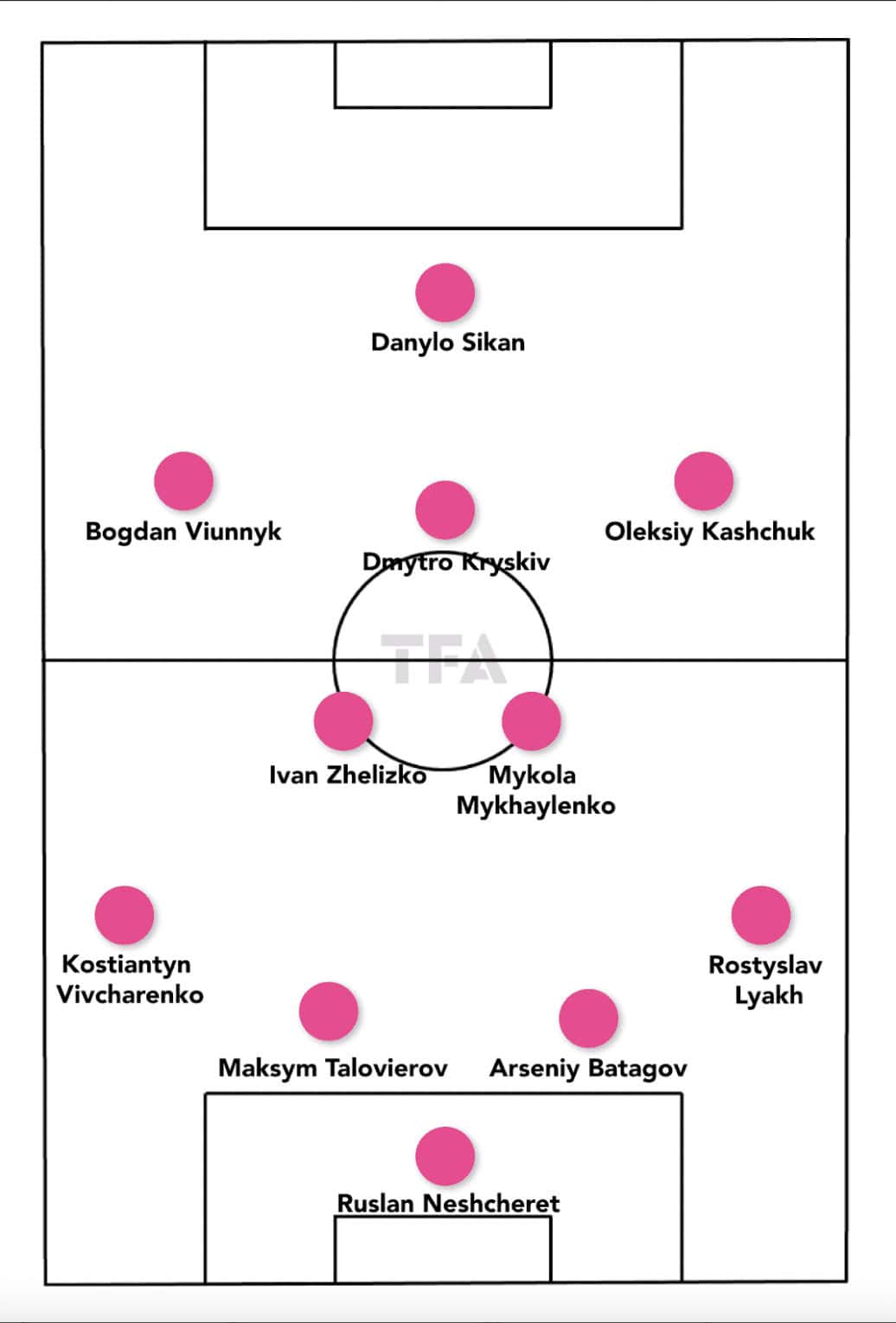
Ruslan Neshcheret will very likely be the main man between the posts for the side. He has enjoyed a breakthrough season with Dynamo Kyiv, starting the majority of their games since the turn of the new year. In the back line, Maksym Talovyerov will be captaining the side in a back four and be one to look out for when the blue and yellow build-up from the back, operating as the center back for his national team youth side.
The two players at the base of the midfield form the heartbeat of the team. Rotan has experimented with different players in his previous few games in charge, however, Ivan Zhelizko and Mykola Mykhaylenko both present a strong case to be in the starting lineup for their first game against Croatia. Mykhaylenko, in particular, demonstrated a keen ability to get on the ball and dictate play in their recent game against Italy.
Further up the pitch sees a couple of notable names, in particular Danylo Sikan who has already made his full international debut for Ukraine with the men’s team, and will look to lead the line for his team as the focal point in attack. Alongside Oleksiy Kashchuk, the two won the FIFA U20 World Cup back in 2019 and will look to bring their experience of success in cup tournaments to the side.
Lastly, Dmytro Kryskiv will play as the attacking midfielder in the supporting cast of the side’s front 3. Often given the license to roam and facilitate build-up, Kryskiv’s technical prowess and ability to work the ball in tight areas will be key for Ukraine.
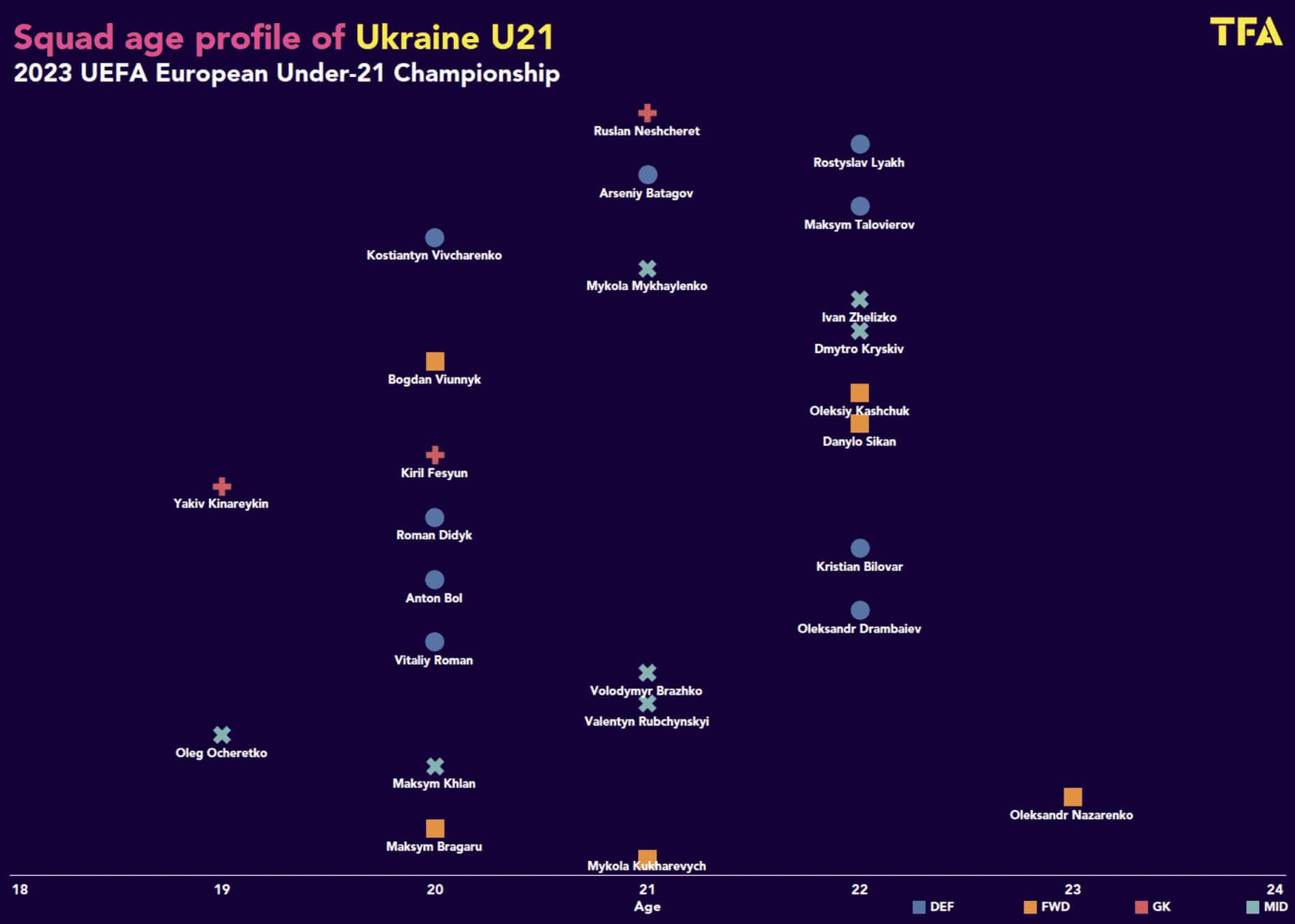
Rotan has a variety of player profiles and ages in his side. Ranging from 19-year-old young talents like Oleg Ocheretko to a 23-year-old experienced ‘veteran’ in Oleksandr Nazarenko, there is a good blend of experience and youthfulness in his side with players like Sikan having already played regular Champions League football this season with Shakhtar Donetsk. It remains to be seen whether or not he will be selected to lead the line, having already made regular appearances with the men’s national team based on his fine performances for his club team.
Overall, Rotan will have a hungry and determined outfit ready to push on from a successful qualifying campaign.
Attacking phase
When looking at the attacking phase of Ukraine, it is notable that the team is disciplined when in possession of the ball.
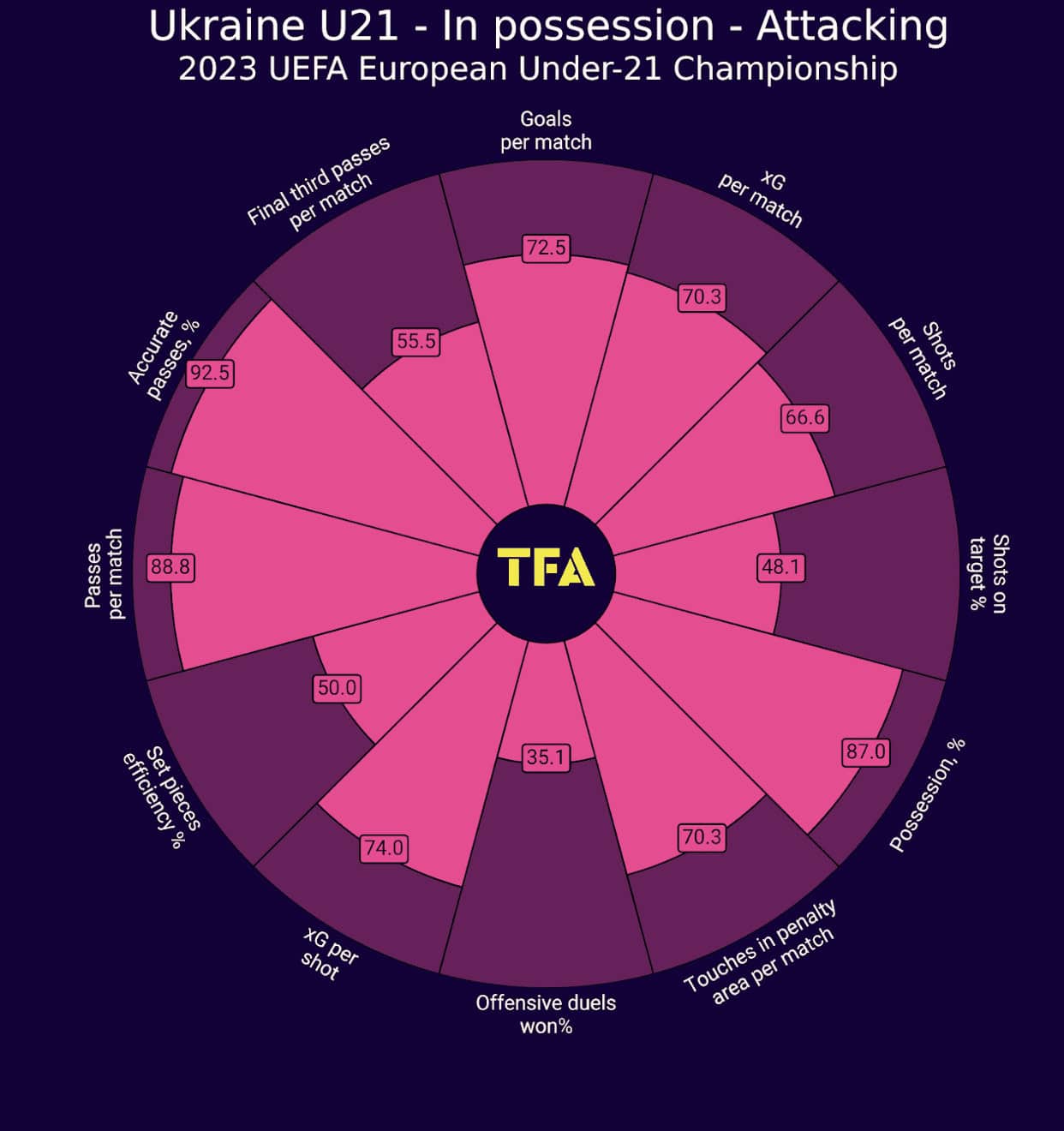
The data shows Ukraine’s propensity to build play out the back and progress the ball slowly up the field, retaining possession in large periods of the games and looking to generate clear chances by exploiting gaps in opposition defences through the movement of the ball. With a 92.5 percentile rank in accurate passes, Rotan encourages his team to circulate the ball along the back line and look to build up play with the help of the two players at the base of midfield.
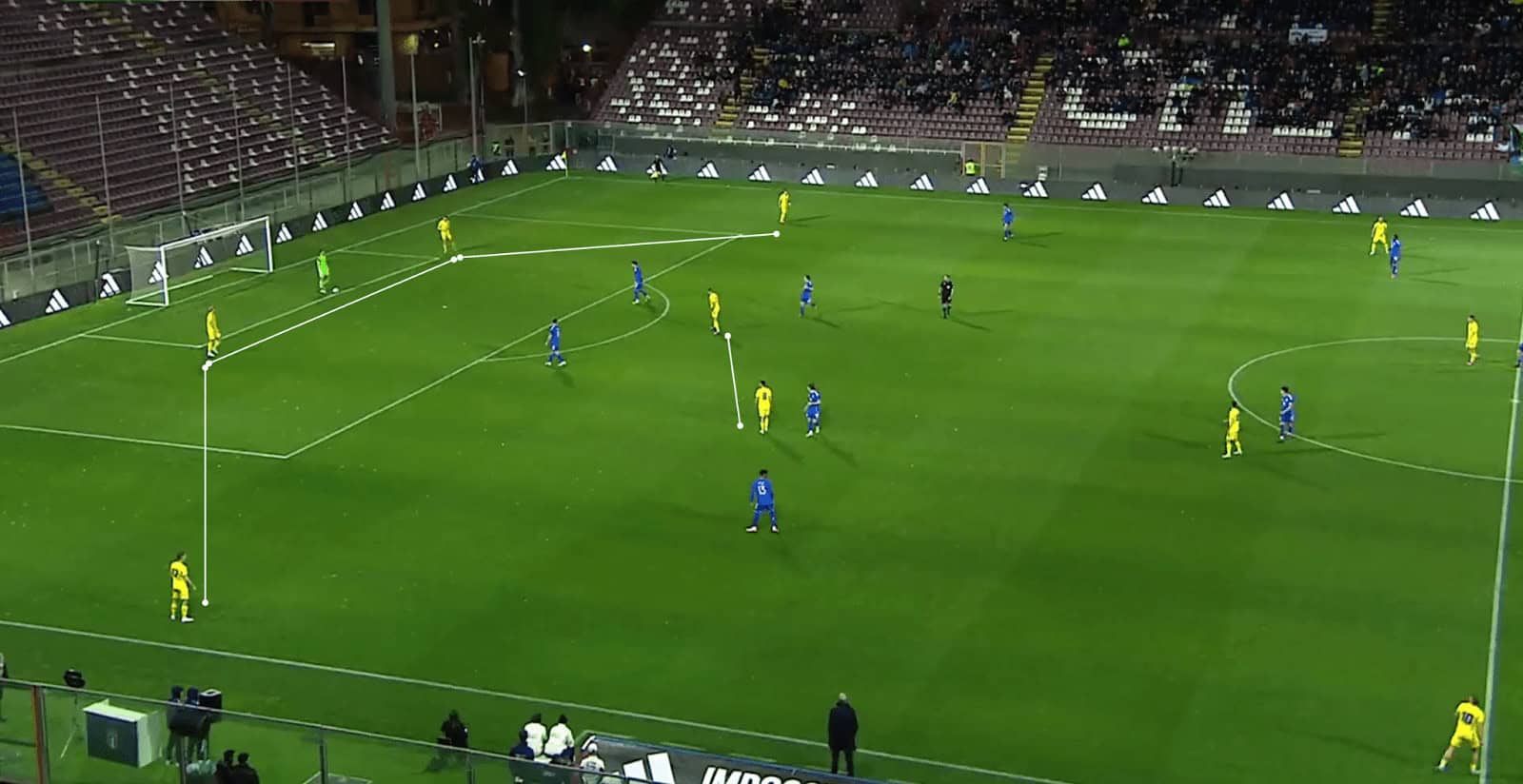
Focusing on Ukraine’s most recent friendly match against Italy’s U21 side in March, when in possession of the ball, the two centre-backs split wide and the goalkeeper steps out to help form a base to circulate the ball across the backline. The two holding midfielders work in tandem with each other, offering vertical support channels, looking to turn on the ball and progress the ball up the pitch. The two midfielders also tend to stay narrow and tight to each other, similar the Roberto De Zerbi’s Brighton, with the goal to bait the press from the opposition and find the extra man, usually the full-backs who are stretching out wide.
At the same time, Kryskiv, operating as a number 10 in this game, steps up alongside Sikan to pin the defenders as high as possible. Often times this creates a 4-2-4 shape during the build-up, with a heavy reliance on the back four and two midfielders (with the support of Neshcheret in goal) to circulate the ball and progress up the pitch.
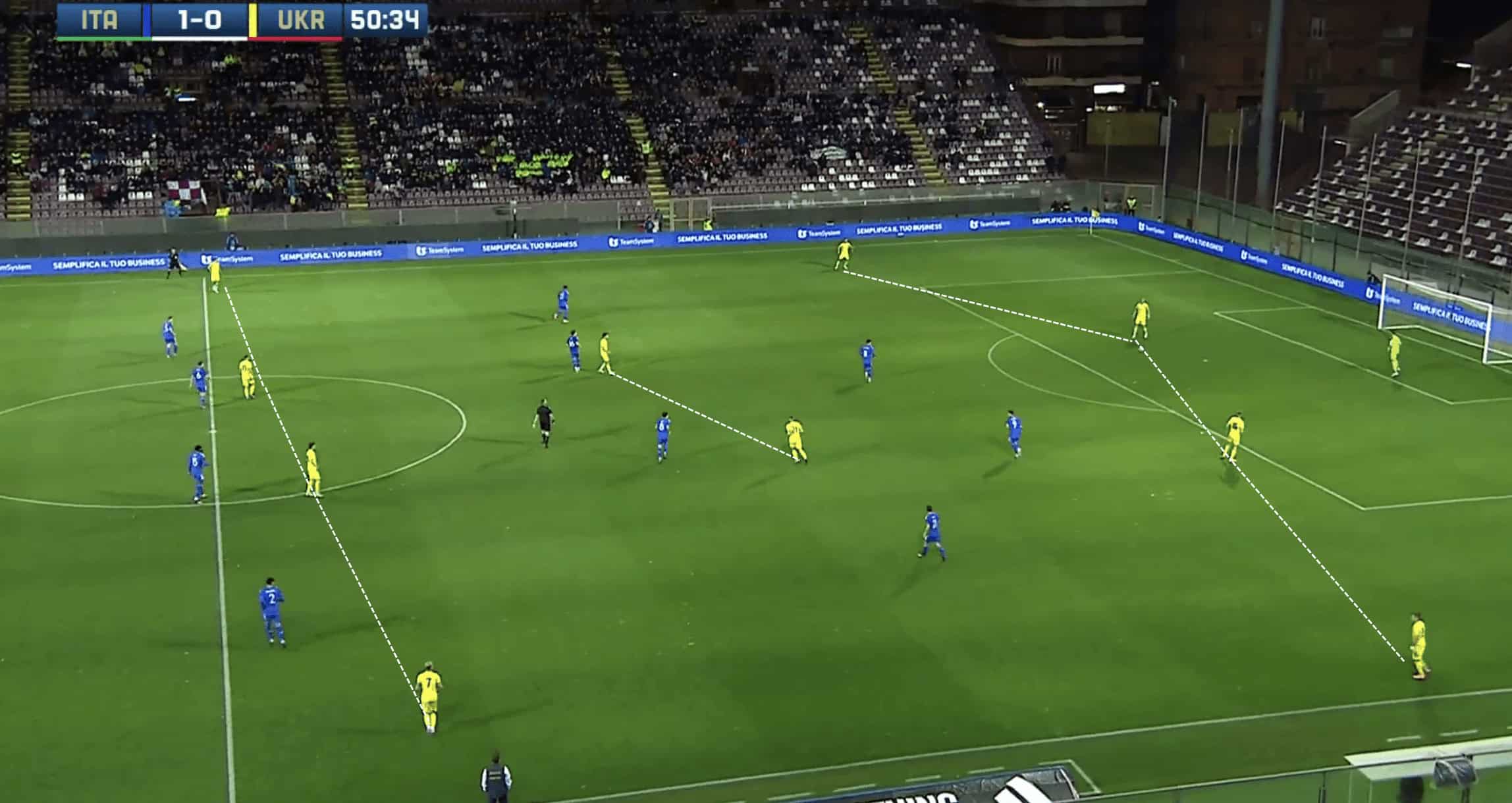
With this rigid build-up system, especially against teams who are willing to commit to a man-to-man press, that leaves 4v4 at the back, Ukraine can struggle to progress the ball effectively up the pitch into the opposition half. The Italians pressed high and often frustrated the Ukrainians who weren’t able to build up effectively. Rotan’s side can be pragmatic, often recognizing a 4v4 match-up further up the pitch, and at times going direct to the front four, but looking at their data, Ukraine are particularly weak when it comes to offensive duels.
When the two holding midfielders do get on the ball, this is often the trigger for Kryskiv to drop into midfield to support the build-up. He often finds himself in half-spaces between the opposition midfielders, and it’s the player Ukraine looks towards linking the play.
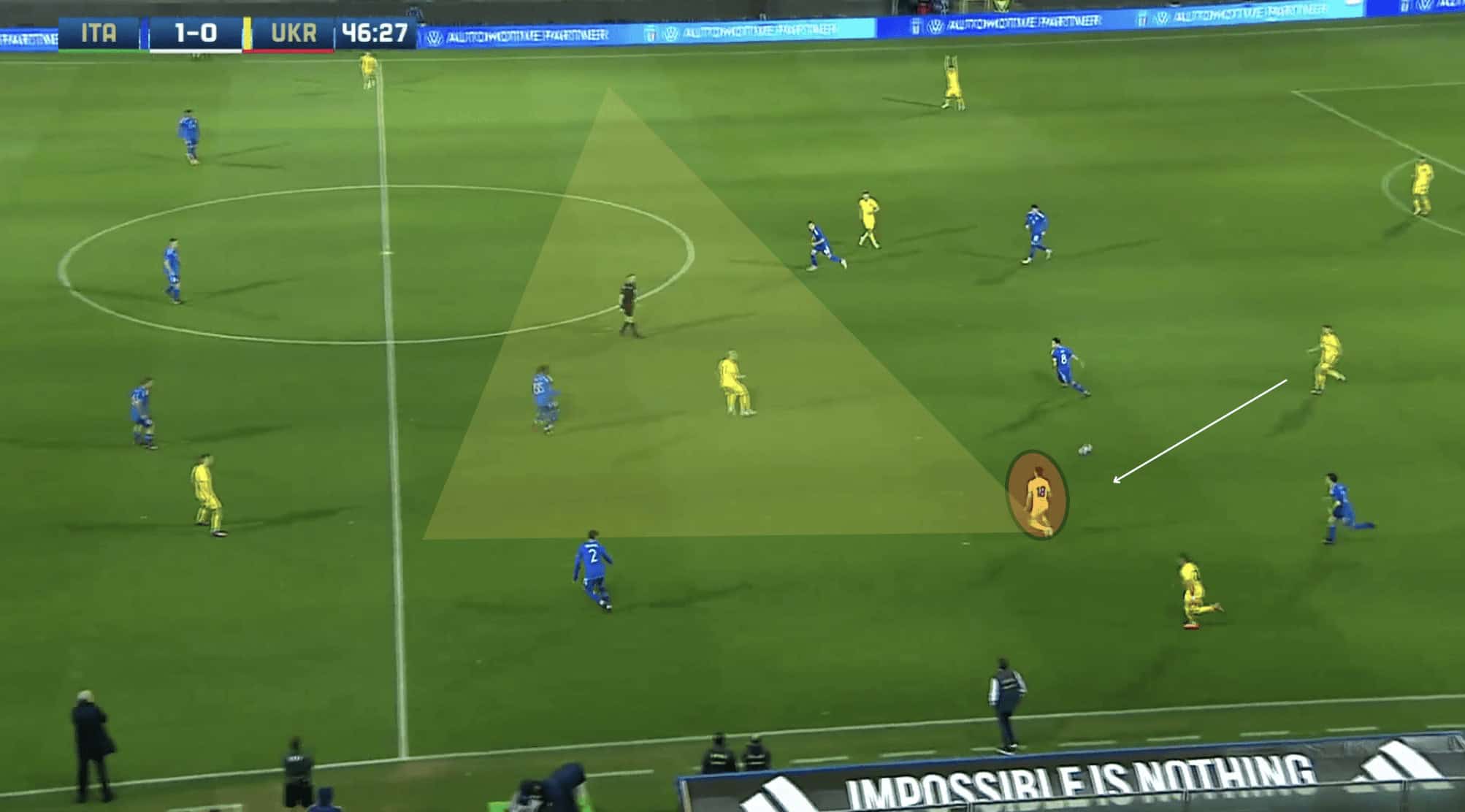
Defensive phase
Rotan likes his team to be on the front foot when in defence. They attempt to apply pressure high up the pitch during opposition goal kicks and build up to dissuade their short passing. Depending on the opposition formation, Kryskiv and Sikan push up to the opposition centre backs, and the two holding midfielders step up to mark to opposition midfielders to force a long pass. Often times Ukraine will set up high, but will stay in formation. This means that their press is rather passive and Ukraine tends to drop back towards their half as teams begin to string the ball across the back four.
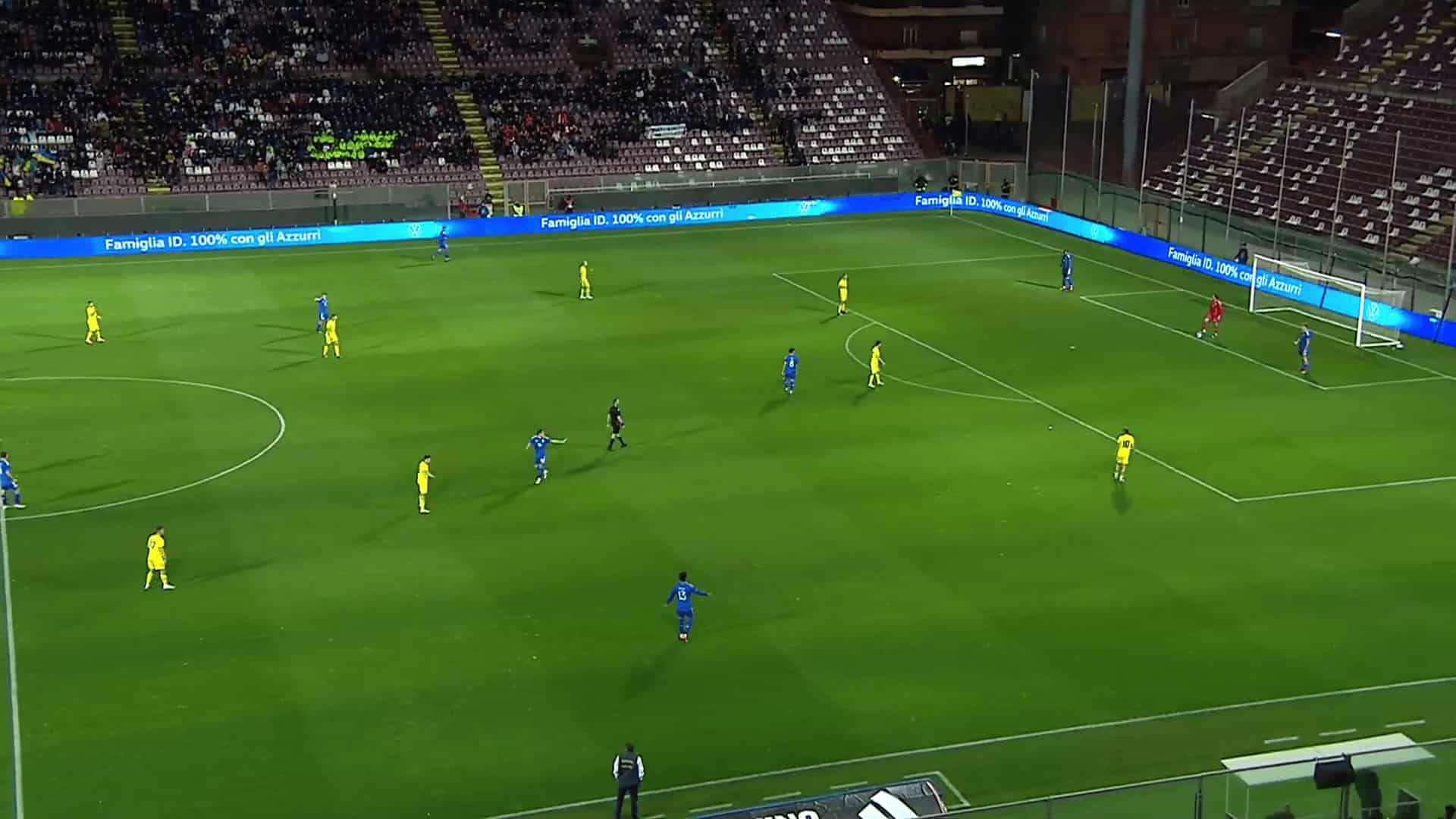
Their intensity of press is conservative, further highlighted by data showing 66.6 PPDA (passes per defensive action). They allow opponents time to circulate the ball around the back, prioritising closing the gaps in midfield rather than committing players forward. This is further demonstrated by their percentage of recoveries in the final third at 48.1%, despite starting high up in the opponent’s third during goal kicks.
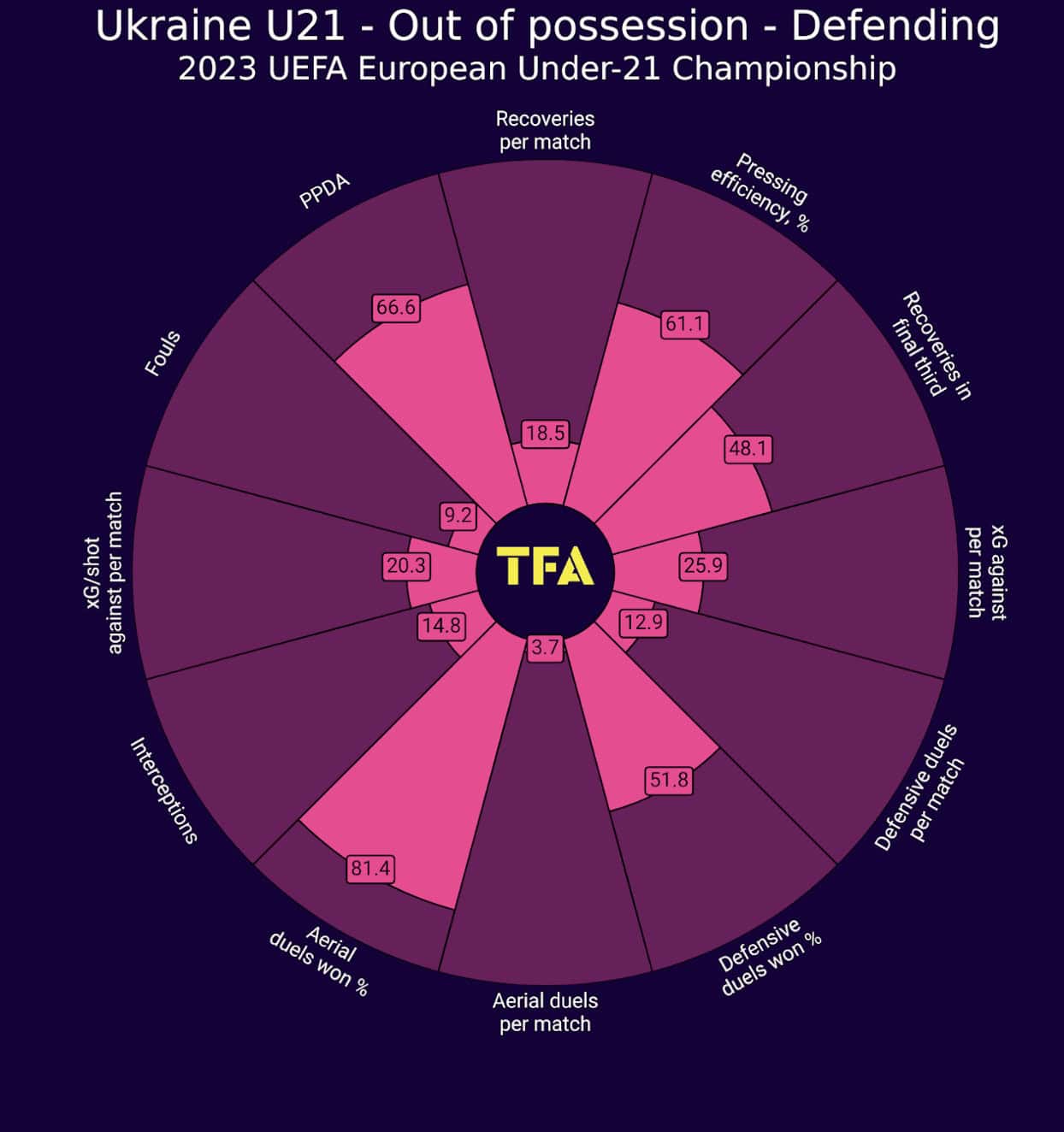
If the opposition team manage to progress the ball up the pitch towards the halfway line, Ukraine sits in a narrow mid-block 4-4-2 formation with Kryskiv pushing up next to Sikan to form the two upfront. A key point on the mid-block is the tendency for the wingers to tuck in narrow alongside the midfield two. This encourages opposition teams to play around the outside of their defensive shape. Rotan encourages his team to apply some pressure on the ball and step out of the block to apply pressure on the player with the ball to stop the easy progression.
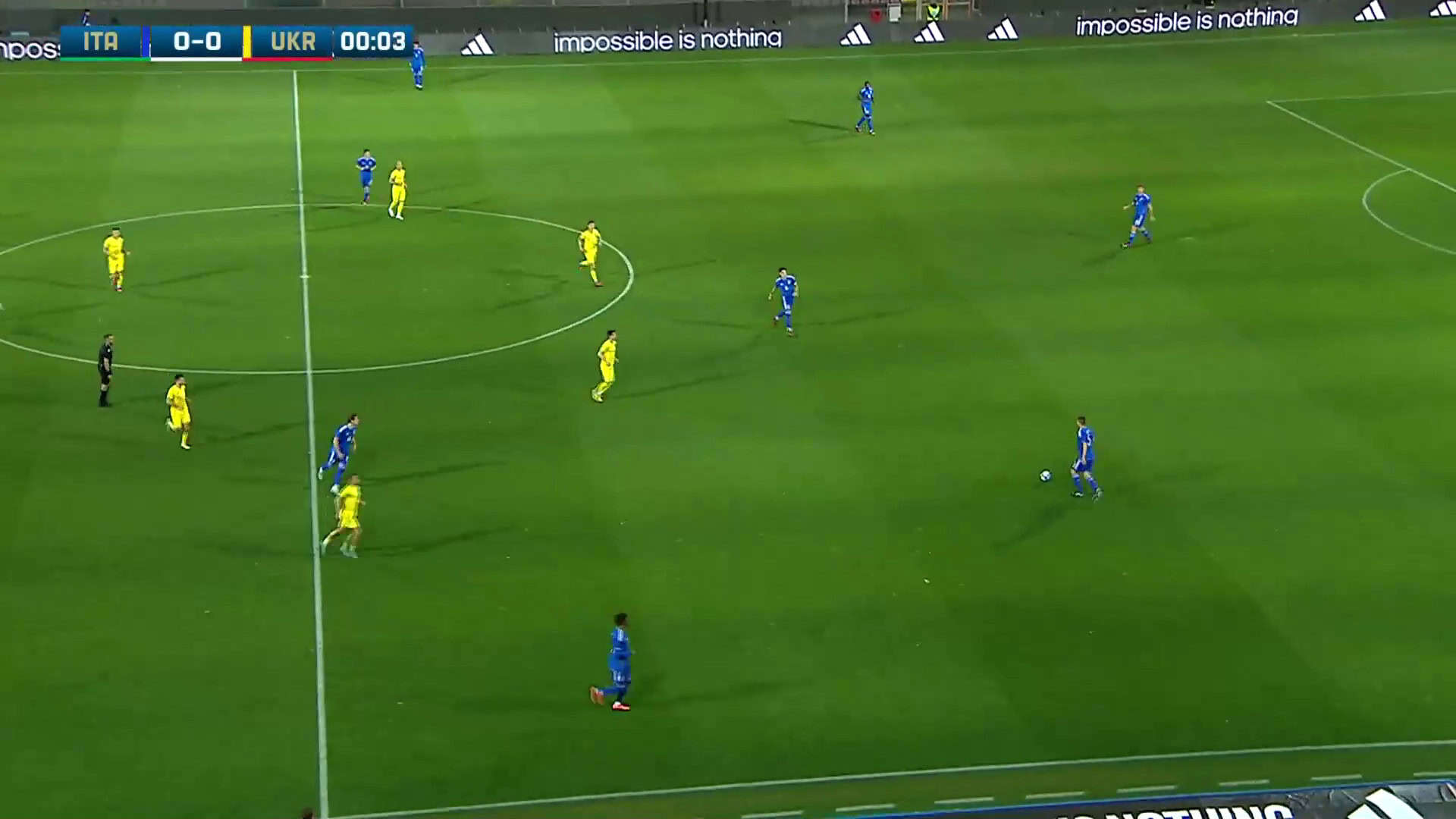
When the opposition has control of possession, Ukraine dictates the opposition wide and by closing channels between midfielders and wingers. Rotan prioritizes his team to work hard as a unit and move across the pitch horizontally as quickly as possible in a narrow block as the ball switches to the opposite side of the pitch. When opponents commit to one side, and the ball progresses to their winger, that is their pressing trigger.
Ukraine press with intent and commit players to win the ball back out wide and prevent a switch of play. This means the midfielders push wide, and the opposite winger comes in narrow to prevent a switch of players through midfield. However, as will be noted later on, Ukraine often struggle to press effectively, and against good teams, over-committing players with a narrow block opens them up for attacks down their opposite side.
Transitions
Ukraine is a side that is full of energy and tenacity. Upon losing possession of the ball, they commit to applying intense pressure on the ball to regain possession or force the opposition to go back towards their own goal. The nearest players will attempt to win the ball back once possession is lost, regardless of their position. This requires commitment and coordination from the players, and Rotan seems to have instilled confidence in their press.

In this image, Ukraine has just lost the ball progressing it in the wide areas. Immediately the players look to jump towards to opposition player to squeeze the space around him and regain possession as fast as possible.
A key factor to their immediate press in transition will be the role of centre-back and captain Talovyerov. The 6 foot 5 inch Ukrainian often steps up from his position, to condense the space in midfield. Opposition teams often look towards their forwards when navigating out of the press, and Talovyerov is comfortable playing on the front foot and stepping midfield when needed.
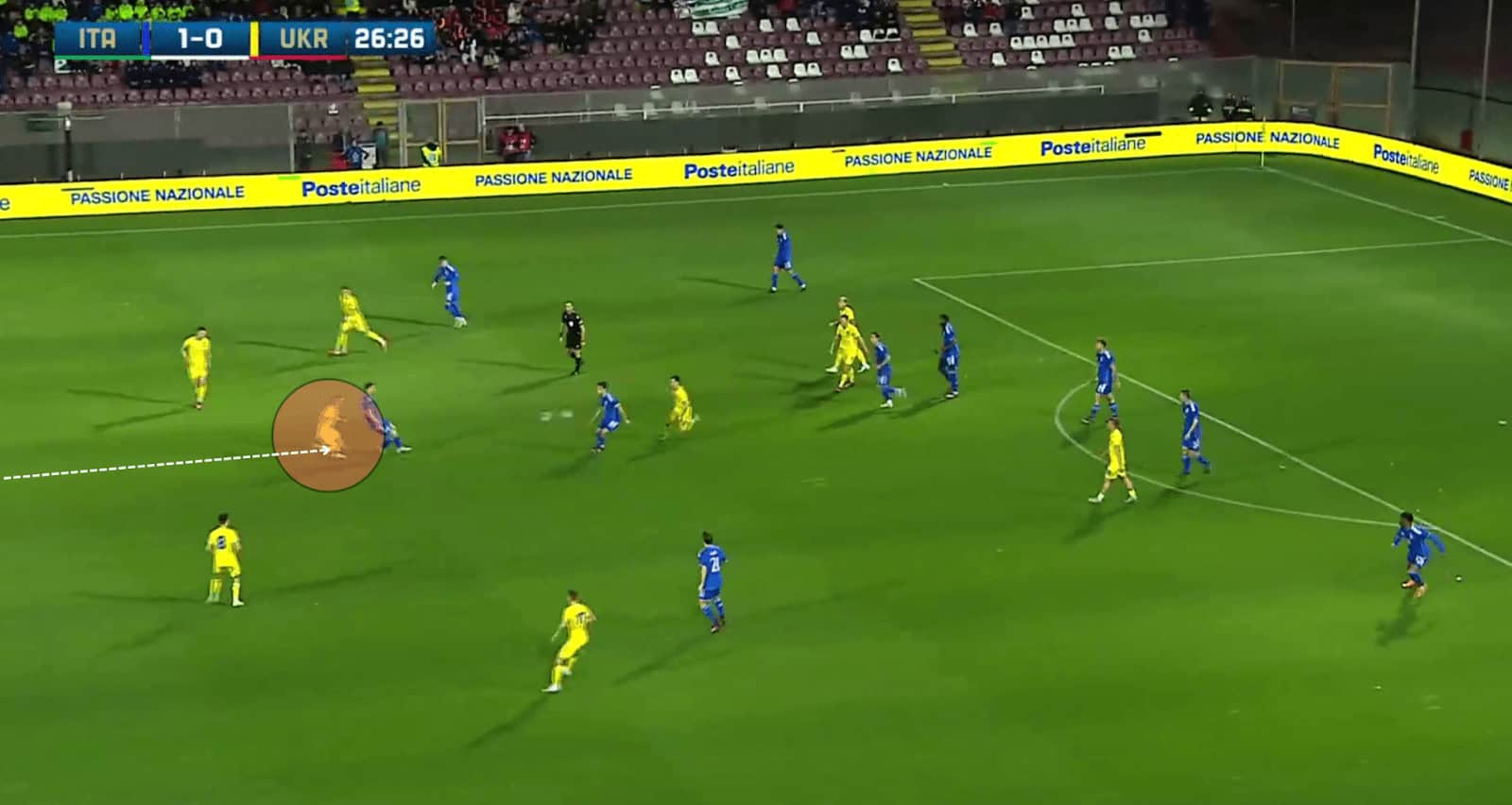
This was effective in forcing the opposition to make mistakes and force errors. However, there were multiple instances where Ukraine was not able to regain possession effectively, as a result, their over-commitment to the press left large areas of the pitch exposed. Italy was able to capitalize on this on a few occasions.
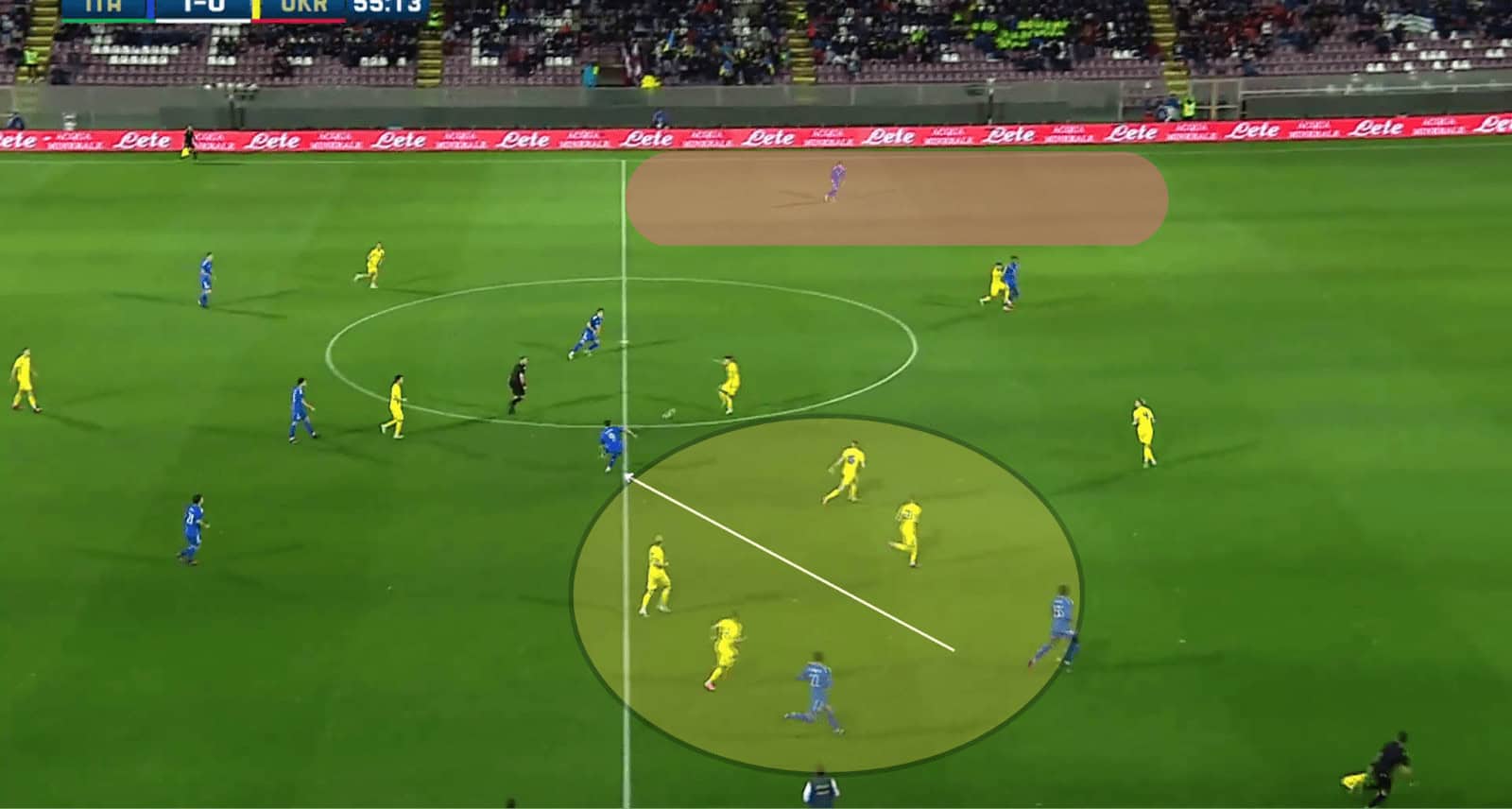
Here we see Ukraine commit four players to press the ball when they lost possession. Italy was able to quickly navigate the ball and switched it to the opposite flank, providing a dangerous 2v1 counter.
When Ukraine was successful in regaining possession, they sought to slow play down and circulate the ball backwards unless there was a clear numerical advantage present. This is crucial to the way Rotan wants his side to play, to dominate possession and create goal-scoring chances methodically.
Attackers
The forward line is where Ukraine finds its brightest talents. As mentioned, Sikan is a particularly interesting case as to whether he continues to play for the U21 side. He already won the FIFA U19 World Cup back in 2019 and has since stepped up into the full men’s national team, accruing six appearances and even scoring a goal against Kazakstan in a World Cup qualifier match.
Kashchuk, another player from Shakhtar Donetsk (currently out on loan), is also an important player for Ukraine in this tournament. Operating as a left footer primarily on the right side, his ability to beat players 1v1 and outstanding technical ability will cause problems for any side he comes up against.
Kashchuk works particularly well in this Ukraine side because of Rotan’s tendency to use his fullbacks to stretch the width, allowing his wingers to operate in the half spaces where Kashchuk is able to receive the ball in dangerous areas and attack directly at goal, registering two goals in his last six appearances for the yellow and blue.
Midfielders
Zhelizko plays at the base in the midfield for Ukraine. With 17 appearances for the U21s, he is a player with vast experience and will be an important player for Rotan, especially with his demand for possession and discipline.
His fellow midfielder Mykhaylenko, a player at Dynamo Kyiv out on loan, is also someone Rotan will look towards to dictate play. Tidy on the ball and able to receive the ball under pressure, it is no wonder his teammates look to him to build possession and no doubt will be another vital player for Ukraine.
A younger player with less experience is Oleh Ocheretko. At 19 years of age, he already has 16 appearances for Shakhtar Donetsk and is currently a regular, out on loan at FC Mariupol. Although not a guaranteed starter, Rotan has frequently looked to Ocheretko to change the flow of games and this may prove the perfect grounds for a star in the making.
Defenders
When looking at defenders, it is hard to look past the captain of the side, Talovyerov. Not only because of his towering height but his aggression and tenancy as the centre-back will also be key for Ukraine if they want to press teams high up the pitch. As mentioned before, Talovyerov can also play as a defensive midfielder as he does at times for his club LASK. This is due to his natural ball-playing abilities, able to pick out midfielders between the lines and slow down the play when needed.
Key player
There are undoubtedly many talented players in this U21 side. If Sikan plays, it is hard to argue against a player who has featured regularly in Europe against sides like Celtic and Real Madrid. He will be the firepower for Ukraine and it will be a joy for all fans if he features in the tournament. Speed, power and finishing ability, the Ukrainian forward will be the the player to look out for.
Nevertheless, the other player that is one that will definitely play a key role for this side, and one of the most exciting players in this Ukraine team is Kryskiv.
At the age of 22, is hard to see him as a young up-and-coming player for Shakhtar Donetsk as he is one of the older players in the Ukraine side. However, with five goals in 16 appearances for his club side, it’s no surprise why some fans and excited to see Kryskiv play this summer.
With incredible technical ability, vision and an eye for goal, Kryskiv is the focal point of his team when he is on the pitch. Receiving the ball in dangerous areas, he has a wonderful ability to pick out a pass or find space for a shot at goal as seen by his high goal contribution per 90 in the data visual below.
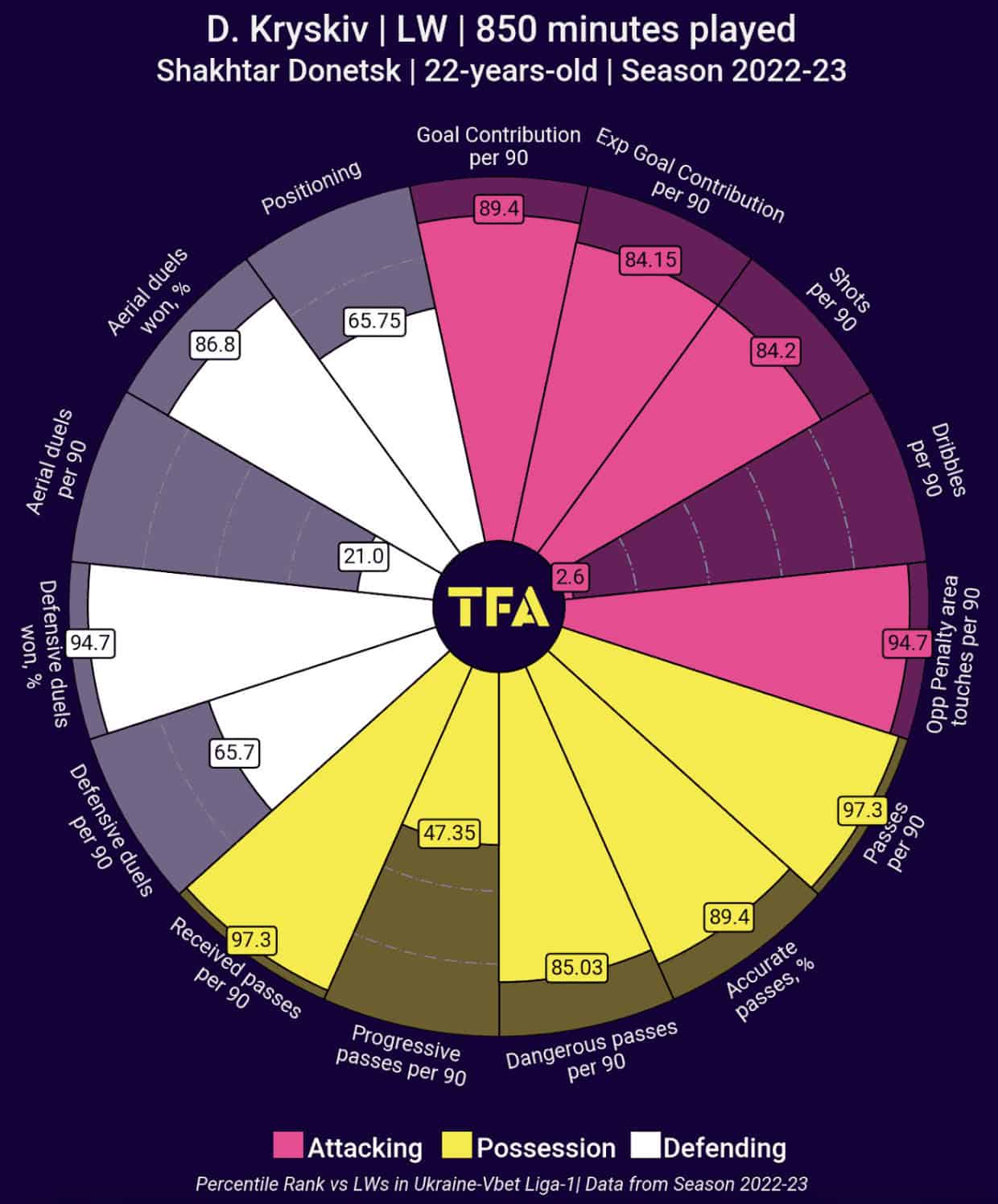
Tournament Prediction
Like Kryskiv, Ukraine will need to be simple and effective if they are to look to beat Spain and progress through to the knockout stages. With the pressure of the recent national youth team’s success, Ukraine will need to work together as a team to implement the demands of coach Rotan in this year’s Euro U21s tournament.
Sikan Kashchuk and Kryskiv will be looked towards to provide the attacking impetus when goals are needed. Talovyerov will need to be at his sharpest if he is to thwart attacks for Croatia and Spain in the group stages. Perhaps this is the opportunity for young Ocheretko to make a name for himself on the big stage and guide Ukraine out of a tricky group. Overall, Ukraine can look towards the summer tournament with optimism, however, it would be more likely to challenge for a second-place finish in the group stages, then look to replicate past glory and reach the finals as they did in 2006.

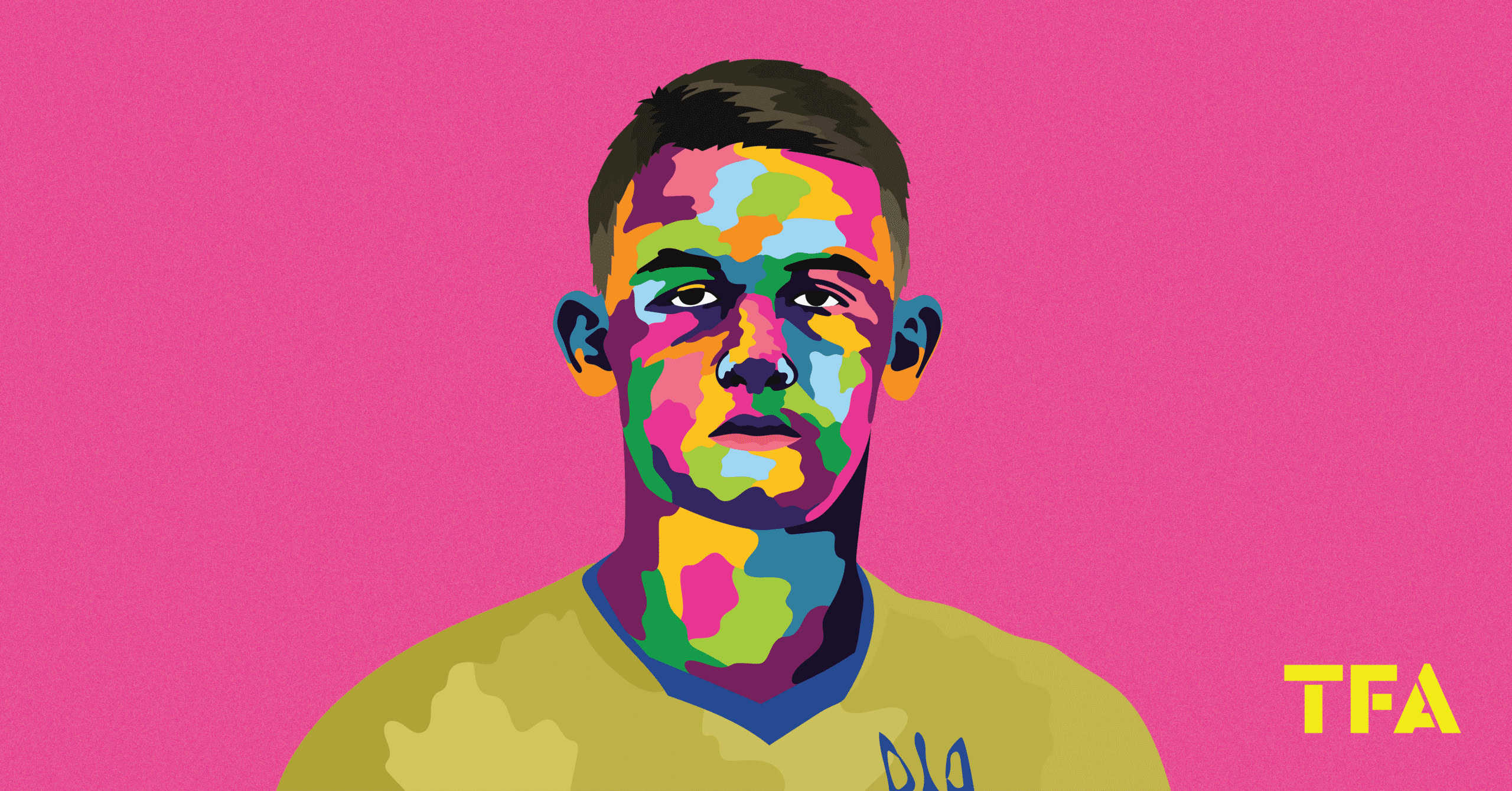



Comments